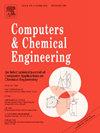从杂乱到清晰:通过问卷度量的紧急神经算子
IF 3.9
2区 工程技术
Q2 COMPUTER SCIENCE, INTERDISCIPLINARY APPLICATIONS
引用次数: 0
摘要
化学工程和生物工程过程中的真实世界数据集-例如来自催化反应器,多相流,聚合反应器,生物反应器和临床试验的数据集-通常是未标记或无组织的,这使得现有监督学习模型的训练在学习潜在动力学方面无效。为了挽救这些数据集用于决策,我们首先寻求从混乱的数据中获得清晰度。在这里,我们提出了一个框架,通过将无监督组织学习技术(问卷)与先进的深度学习架构(深度隐藏物理模型和深度算子网络)相结合,开发“结构”生成模型,发现紧急方程,并从混乱的数据集构建有效的模拟器。我们的方法在两个说明性模型系统上得到了证明:(a)一个表示弯曲地下管道的一维平流扩散偏微分方程和(b)一个Stuart-Landau振荡系综,一个基于agent的耦合常微分方程系统。在这两种情况下,我们都成功地从混乱的数据中重建了有意义的空间、时间和参数嵌入,从而实现了对系统动力学的良好预测。我们强调了该框架在更广泛应用中的潜力,使数据驱动的系统识别能够在具有固有无序或隐藏参数空间的领域中实现。本文章由计算机程序翻译,如有差异,请以英文原文为准。

From clutter to clarity: Emergent neural operators via questionnaire metrics
Real-world datasets in chemical engineering and bioengineering processes—such as those from catalytic reactors, multiphase flows, polymerization reactors, bioreactors, and clinical trials—can often be unlabeled or disorganized, rendering the training of existing supervised learning models ineffective at learning the underlying dynamics. To salvage these datasets for decision-making, we first seek to obtain clarity from the cluttered data. Here, we present a framework for developing “structural” generative models, discovering emergent equations, and constructing efficient emulators from scrambled datasets by integrating unsupervised organizational learning techniques (Questionnaires) with advanced deep learning architectures (Deep Hidden Physics Models and Deep Operator Networks). Our approach is demonstrated on two illustrative model systems: (a) a 1D advection–diffusion partial differential equation representing a winding underground pipe and (b) an ensemble of Stuart–Landau oscillators, an agent-based system of coupled ordinary differential equations. In both cases, we successfully reconstruct meaningful spatial, temporal, and parameter embeddings from scrambled data, enabling good predictions of system dynamics. We highlight the framework’s potential for broader applications, enabling data-driven system identification in fields with inherently disorganized or hidden parameter spaces.
求助全文
通过发布文献求助,成功后即可免费获取论文全文。
去求助
来源期刊

Computers & Chemical Engineering
工程技术-工程:化工
CiteScore
8.70
自引率
14.00%
发文量
374
审稿时长
70 days
期刊介绍:
Computers & Chemical Engineering is primarily a journal of record for new developments in the application of computing and systems technology to chemical engineering problems.
 求助内容:
求助内容: 应助结果提醒方式:
应助结果提醒方式:


